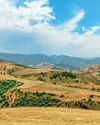
Time and again, during that winter of 1923 to 24, members of some isolated Eskimo* tribe, peering from the entrances of their snug igloos, could hardly believe their eyes. Through the deadly cold, the howling wind and lashing snow, came a man—a white man. Ignoring any weapons aimed at him, the stranger flashed a grin and joked in fluent Eskimo language. “Now, is that any way to greet a friend who has come so far to see you? What are we having for dinner?”
Thus, Knud Rasmussen, the inimitable Danish explorer and ethnologist, forged and charmed his way steadily westwards across the whole bleak and stormy roof of North America. When he reached Nome in mid-1924, he had completed the longest, most remarkable sledge journey in Arctic annals. The winding course he had followed in order to seek out hundreds of tribal villages scattered from Hudson Bay to the Pacific had taken him, in three years, some 32,000 kilometers.
The feats of this master explorer are still relevant today. Thanks partly to Rasmussen’s wanderings, his native Greenland, once a precariously claimed Danish colony, is now undisputedly Danish territory. Thus, little Denmark holds sway over a 217.5 million hectare area, 50 times the size of herself, and not quite as large as India.
The outpost of Thule [now called Qaanaaq], Greenland, founded by Rasmussen, is still the northernmost major settlement on the globe** as well as the site of the free world’s largest ballistic missile centre and early warning station. Today, Rasmussen’s writings remain the leading authority on the more primitive Eskimo tribes.
This story is from the {{IssueName}} edition of {{MagazineName}}.
Start your 7-day Magzter GOLD free trial to access thousands of curated premium stories, and 9,000+ magazines and newspapers.
Already a subscriber ? Sign In
This story is from the {{IssueName}} edition of {{MagazineName}}.
Start your 7-day Magzter GOLD free trial to access thousands of curated premium stories, and 9,000+ magazines and newspapers.
Already a subscriber? Sign In

Demonstrators by Krishna Reddy
1968 Multicolour viscosity, Print on paper

Notes from Grief Camp
Every summer, more than a hundred children come together to spend a weekend swimming, climbing and canoeing. They also learn to deal with death

Six Places Cheese Lovers Should Visit
Ancient caves, monasteries, and other must-sees for fromage fans

THE LAND OF SUPERCEN TENARIANS
A remote region of Azerbaijan claims to have many extremely long-lived residents. What is their secret, or is it just a myth?

The Whistle Blowers
My grandparents had a distinctive way of communicating

"THE NEXT AIRCRAFT WILL CRASH ON LANDING"
THE JET WAS ALMOST OUT OF FUEL. THE PILOTS' ONLY OPTION WAS A MANOEUVRE NO ONE HAD EVER ATTEMPTED.

The Secrets in our Genes
Genomic sequencing tests can reveal much about your unique physiology. But are they worth it?

GOOD NEWS FROM AROUND THE WORLD
MENTAL HEALTH When her son was arrested last year, Tambudzai Tembo's mind went to dark thoughts of suicide.

Into the Inferno
A gas station owner has seconds to react when a car crashes into a gas pump

THE CLIMATE CHANGERS
THESE PLACES ARE LEADING THE WAY TO A FUTURE FREE OF FOSSIL FUELS